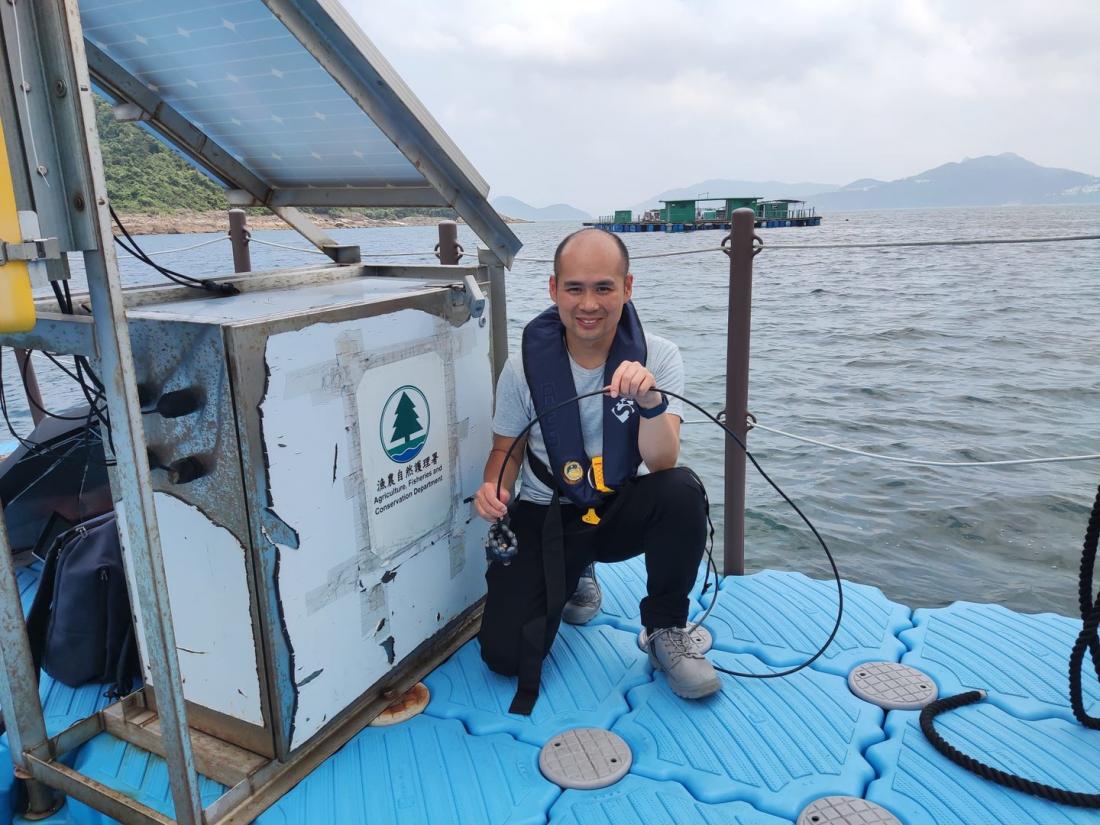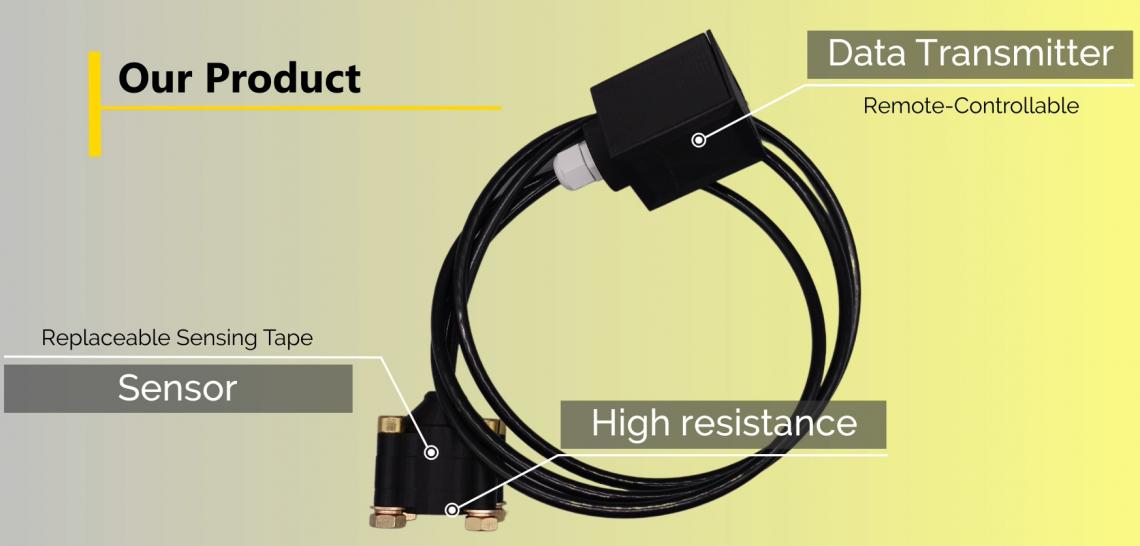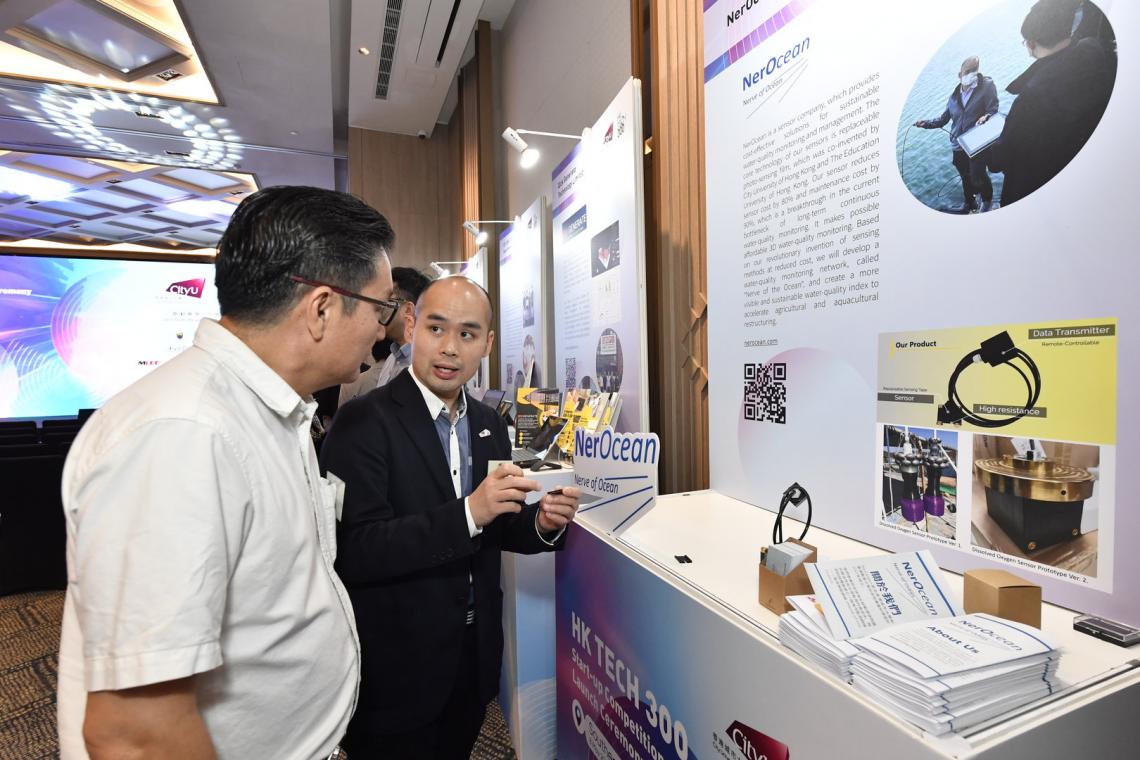NerOcean collaborates with government departments such as the Agriculture, Fisheries and Conservation Department to test its dissolved oxygen sensors in Hong Kong waters to monitor the oxygen content of seawater. The photo shows Dr Ng Chi-on, one of the founders of NerOcean. (Photo source: NerOcean)
NerOcean's technology was developed jointly by a team from CityU and The Education University of Hong Kong in 2018. Dr Ng recalled, “I was engaged in postdoctoral research under supervision of Professor Vincent Ko Chi-chiu at CityU at the time. I was exposed to different knowledge transfer projects, including cooperation with various industries, which helped me understand the importance of transforming research results into practical applications.” The launch of HK Tech 300 reinforced the determination of Dr Ng and his team to transform their research results into practical applications with the establishment of the start-up.
Establishing a seawater oxygen monitoring network to maintain the marine ecosystem
Oxygen concentration in seawater (known as “dissolved oxygen”, or “DO”) can decline due to factors such as population growth, climate change and environmental pollution, causing malformation, infertility and even death for many marine species. This poses a huge threat to the entire ecosystem and food chain. Scientists are constantly studying the oxygen content in the ocean. But owing to the rapid change in DO in different locations and within short periods of time, this requires many sensors. In addition, biofouling significantly increases the maintenance costs of the sensors. This presents a huge challenge for long-term, large-scale seawater DO monitoring.
NerOcean, derived from “Nerve of the Ocean”, intends to build an efficient, low-cost ocean monitoring system with their “DO sensors”. NerOcean’s sensors apply “replaceable photo-sensing film” photochemical reaction technology. The ultraviolet light source of the sensors triggers an photochemical reaction between the sensing material on the film and DO in the seawater. Relevant data is then transmitted to the team’s land-based devices to record changes in the oxygen content of the seawater in real-time.
A new generation of dissolved oxygen sensors developed by NerOcean enable real-time, long-term monitoring of the oxygen content in seawater. (Photo source: NerOcean)
Solving the problem of biofouling on sensors to reduce maintenance costs
“The sensor’s replaceable photo-sensing film works like a recording tape. Only a small section of the film is exposed to a light source for each measurement,” explained Dr Ng. “After completing the measurement, the sensor automatically rotates the film to a new section and targets the light source for the next measurement. This allows the photochemical reaction of DO to be recorded over a long period of time for long-term ocean surveillance.”
The team’s thin-film technology improves the selectivity of DO, providing more accurate monitoring. Furthermore, the sensing material on the film reacts to oxygen only under a specific light source. Since NerOcean’s sensor itself has a light source, the system is not affected by light changes underwater. The use of an ultraviolet light source also inhibits the growth of marine organisms on the film, reducing maintenance costs caused by biofouling when using the replaceable photo-sensing films. “At present, the sensors generally need to be cleaned every two weeks, but our goal is to extend this to half a year,” Dr Ng added.
NerOcean joined the launch ceremony of the HK Tech 300 Southeast Asia Start-up Competition in Kuala Lumpur, Malaysia in May last year. (Photo source: CityU)
HK Tech 300 provides multi-faceted support to nurture researchers to become entrepreneurs
Transforming research results into products and launching them in the market often leads to many setbacks and difficulties, but Dr Ng believes in “persistence” and has overcome many difficulties on the entrepreneurship road with support from many parties.
As a researcher at university, he did not know how the business world works. “The mindsets required for research and business are very different. When doing research, we focus on the knowledge and results that we want to obtain; but in the business world, we also have to solve the problems of our customers. After my contact with the business and industrial communities, I now think more about the problems that other parties and customers need to solve. Can I help them solve these problems? If not, what other possibilities are there? The needs of others come first now,” he said.
He was hesitant at the beginning, asking “Should I start a business based on my research outputs?” When he learnt about HK Tech 300 Innovation and Entrepreneurship Programme, he found that it provides entrepreneurship training, helping him to learn about business operations, business models and proposal development, and offers opportunities to network with industry and investors. And HK Tech 300 has created a unique start-up ecosystem, bringing together start-up teams from different sectors, which can support and encourage each other on technology development and the entrepreneurial journey.
Research in line with the world – integration of industry, academia and research
“In the past, we used to do research rigorously in the laboratory. With the support of HK Tech 300 and the entrepreneurial experience in the past two to three years, we have had more opportunities to connect with the outside world,” he said. “Today, we are still very dedicated to technology research and development. We must do it and do it well. But at the same time, we also try to understand the needs of industry and provide corresponding solutions.” He also noted that many scientific research colleagues in Hong Kong are working on commercialising their research outputs. He believes that this will become the mainstream trend.
NerOcean is currently collaborating with government departments, such as the Agriculture, Fisheries and Conservation Department and the Environmental Protection Department, to test the sensors in five to six aquaculture areas in Hong Kong. The third phase of prototype development is expected to be launched from June to July this year. NerOcean aims to market the sensors in some coastal cities in the mainland, focusing first on the Greater Bay Area, where they hope to establish production lines and partnerships with local companies in the future.
The team is also collaborating with CityU’s State Key Laboratory of Marine Pollution to launch a project called “Artificial Mussels” to monitor the content of heavy metals and radioactive substances in the ocean. They plan to test it in nearly 100 estuaries in 50 countries around the world, contributing to the sustainable development of blue economy and the planet.





